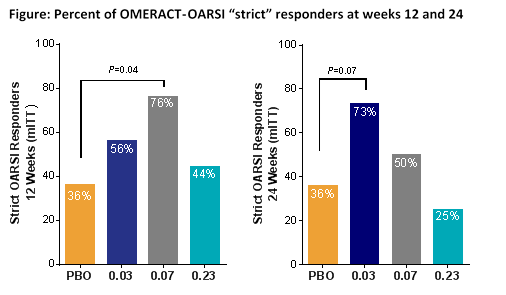Session Information
Session Type: ACR Poster Session C
Session Time: 9:00AM-11:00AM
Background/Purpose: Knee osteoarthritis (OA) is characterized by pain, functional impairment, disability, and joint space narrowing due to degradation of articular cartilage and bone remodeling. The Wnt signaling pathway is known to play a central role in the formation of joint tissues, and altered Wnt signaling has been associated with cartilage loss in preclinical and clinical studies.1 SM04690 is a small molecule inhibitor of the Wnt pathway in development as a potential OA therapeutic to be administered as an intra-articular (IA) injection into the affected joint. A phase 1, first-in-human, multicenter, 24-week, single-dose-escalation, randomized controlled trial (RCT) of SM04690 was completed. It assessed safety and tolerability of SM04690 administered IA to subjects with moderate to severe OA. This report provides a breakdown of components driving the Outcome Measures in Rheumatology (OMERACT)-Osteoarthritis Research Society International (OARSI) strict responder data to further evaluate proof of concept of efficacy of SM04690.
Methods: In the completed phase 1 RCT, escalation cohorts were dosed at 0.03 mg, 0.07 mg, and 0.23 mg SM04690 per 2 mL injection, in cohorts of 20 subjects (randomized, 16 active: 4 placebo). Subjects were administered a single IA injection in the target knee on treatment day 1, and participated in a follow-up period of 24 weeks. Safety, pharmacokinetics (PK), biomarker, and preliminary efficacy data, including the Western Ontario and McMaster Universities Arthritis Index (WOMAC Likert v3.1), were collected. The percentage of OMERACT-OARSI “strict” responders in the modified Intention-to-Treat (mITT) population were evaluated. “Strict” responders were defined as reporting either WOMAC Function subscore or WOMAC pain subscore improvement of ≥50% coupled with at least a 20-point reduction in the given subscore (scaled to [0-100]).
Results: Sixty-one subjects (average age 62.6 [±5.7] years, female n=41 [67%], average BMI 30.4 [±4.7] kg/m2) were enrolled. Versus placebo, there were statistically more OMERACT-OARSI strict responders in the 0.07 mg cohort at week 12 (76% vs. 36%; P=0.04), and numerically more in the 0.03 mg cohort at week 24 (73% vs. 36%; P=0.07) (Figure). More subjects in the 0.07 mg cohort met both the pain and function criteria vs placebo at 12 weeks (53% vs. 36%), and 24 weeks (44% vs. 27%). Responses in the 0.23 mg cohort were 44% at week 12 and 25% at week 24.
Conclusion:
Analysis of OMERACT-OARSI strict responders in this phase 1 study provides evidence of a potential treatment effect on both OA pain and function for the novel Wnt inhibitor SM04690 compared with placebo. These data support further development in an ongoing phase 2 RCT.
Reference:
1. Gelse K. Osteoarthr Cartil. 2012; 20(2):16271
To cite this abstract in AMA style:
Strand V, Swearingen CJ, Simsek I, DiFrancesco A, Tambiah J, Yazici Y. Analysis of Pain and Function Components in Omeract-Oarsi Strict Responders from a Randomized, Double-Blind, Placebo-Controlled, Phase 1 Study of a Novel, Intra-Articular, Injectable, Wnt Inhibitor (SM04690) in the Treatment of Osteoarthritis of the Knee [abstract]. Arthritis Rheumatol. 2016; 68 (suppl 10). https://acrabstracts.org/abstract/analysis-of-pain-and-function-components-in-omeract-oarsi-strict-responders-from-a-randomized-double-blind-placebo-controlled-phase-1-study-of-a-novel-intra-articular-injectable-wnt-inhibitor-s/. Accessed .« Back to 2016 ACR/ARHP Annual Meeting
ACR Meeting Abstracts - https://acrabstracts.org/abstract/analysis-of-pain-and-function-components-in-omeract-oarsi-strict-responders-from-a-randomized-double-blind-placebo-controlled-phase-1-study-of-a-novel-intra-articular-injectable-wnt-inhibitor-s/

